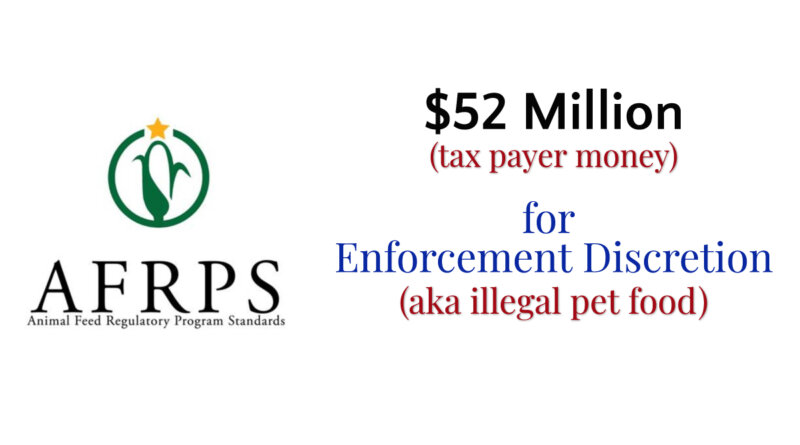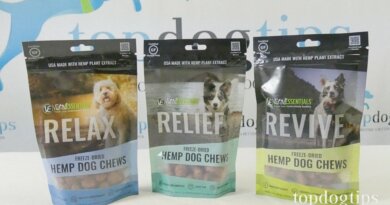The $52 Million Pet Feed Scam – Truth about Pet Food
[ad_1]
Over the past 5 years, $52 million of your tax dollars were sent to 23 states to regulate pet food and animal feeds. Unfortunately, your money was not spent on enforcing law.
Starting in 2008, the Food and Drug Administration began a cooperative agreement with U.S. states to uniformly regulate manufactured foods. The agreement – Manufactured Foods Regulatory Program Standards – provided federal funding to states that agreed to develop state laws similar to federal laws, train regulatory staff to proper inspection and enforcement procedures, and update state laboratories for uniform testing of manufactured foods.
There are 43 U.S. states that participate in the Manufactured Foods Regulatory Program Standards. Since its beginning, FDA has provided 23 of the 43 states more than $55 million in financial support to implement the Manufactured Foods Regulatory Program Standards.
We provide the financial support ($55 million) for only 23 states because those same 23 states also participate in another regulatory agreement with FDA. These 23 U.S. states participate in the Animal Feed Regulatory Program Standards; a separate cooperative agreement between FDA and U.S. states to uniformly regulate pet food/animal feed. The Animal Feed Regulatory Program Standards also provides federal funding to states that agree to develop state laws similar to federal laws, train regulatory staff to proper inspection and enforcement procedures, and update state laboratories for uniform testing of pet foods/animal feeds.
Since its beginning in 2011, FDA has provided 23 states more than $52 million in financial support to implement the Animal Feed Regulatory Program Standards.
The Standards of the two FDA funded programs are almost identical.
So why is FDA sending duplicate money to 23 states if the requirements are almost identical; $55 million for MFRPS and $52 million for AFRPS?
In many cases, the federal funding for both programs is sent to the exact same state government department. As example, the Florida State Department of Agriculture & Consumer Services is responsible for implementing both the Manufactured Foods Regulatory Program Standards and the Animal Feed Regulatory Program Standards. Florida Department of Agriculture has received $4,946,085.00 of federal funding from FDA since 2014 to implement the Manufactured Foods Regulatory Program Standards, and Florida Department of Agriculture has received $3,135,192.00 of federal funding from FDA since 2015 to implement the Animal Feed Regulatory Program Standards.
(Sources: https://taggs.hhs.gov/Detail/AwardDetail?arg_AwardNum=U18FD005757&arg_ProgOfficeCode=1, https://taggs.hhs.gov/Detail/AwardDetail?arg_AwardNum=U18FD003604&arg_ProgOfficeCode=1, https://taggs.hhs.gov/Detail/AwardDetail?arg_AwardNum=U18FD006413&arg_ProgOfficeCode=1, https://taggs.hhs.gov/Detail/AwardDetail?arg_AwardNum=U18FD004916&arg_ProgOfficeCode=1, and https://taggs.hhs.gov/Detail/AwardDetail?arg_AwardNum=U18FD005628&arg_ProgOfficeCode=1)
Again, why is FDA providing duplicate federal funding for almost identical regulatory standards? Why are pet foods/animal feeds not considered ‘manufactured foods’ and regulated the same?
The answer could be FDA’s favorite two words…Enforcement Discretion.
The Manufactured Foods Regulatory Program includes human food, the Animal Feed Regulatory Program Standards is for pet food/animal feed ONLY. To place pet food in the same regulatory standard as human food would mean that pet food would have to abide by the same laws as human food. We know from FDA own words, pet food is NOT regulated the same as human food. The FDA stated in April 2019:
“we do not believe that the use of diseased animals or animals that died otherwise than by slaughter to make animal food poses a safety concern and we intend to continue to exercise enforcement discretion.”
(The exception would be pet foods labeled as “Human Grade”. Pet foods with the words “Human Grade” printed on the label abide by all human food safety law.)
In order for FDA to get away with their enforcement discretion, in order for FDA to allow pet food/animal feed to violate federal law – the regulation of pet foods and animal feeds had to separate from the regulation of human foods. That separation has cost U.S. tax payers more than $52 million in just 5 years.
One of the requirements of both federally funded programs is to have equivalent state laws to the Federal Food Drug and Cosmetic Act. The Animal Feed Regulatory Program Standards requires state pet food/animal feed laws to be equivalent to the Federal Food Drug and Cosmetic Act.
As example, the state of Florida has received $3,135,392.00 from FDA for implementation of the Animal Feed Regulatory Program Standards. Florida complies with the Standard by having state commercial feed laws (which regulate pet food and livestock feed) that are equivalent to the Federal Food Drug and Cosmetic Act as exampled below.
Federal Food Drug and Cosmetic Act Adulterated Food (in part): “if it is, in whole or in part, the product of a diseased animal or of an animal which has died otherwise than by slaughter“.
Florida Commercial Feed statutes (in part): “If it is, in whole or in part, the product of a diseased animal or of an animal that has died by a means other than slaughter which is unsafe within the meaning of s. 402(a)(1) or (2) of the Federal Food, Drug, and Cosmetic Act.“
Each state participating in the Animal Feed Regulatory Program Standards has performed the same requirements of implementation and in return has received significant funding from FDA.
Alabama Department of Agriculture – $299,780.00
California State Department of Food & Agriculture – $2,250,000.00
Colorado Dept of Agriculture – $2,307,330.00
Connecticut Dept of Agriculture – $1,891,673.00
Florida Department of Agriculture – $3,135,392.00
Georgia Department of Agriculture – $2,250,000.00
Illinois Department of Agriculture – $589,162.00
Iowa Department of Agriculture – $3,150,000.00
Kansas Department of Agriculture – $2,250,000.00
University of Kentucky Division of Regulatory Services – $2,400,000.00
Louisiana Department of Agriculture & Forestry – $2,591,327.00
Michigan State Department of Agriculture – $1,350,000.00
Minnesota Department of Agriculture – $2,325,000.00
Missouri Department of Agriculture – $3,063,115.00
New Jersey Department of Agriculture – $3,024,848.00
New Mexico Department of Agriculture – $3,150,000.00
Nebraska Department of Agriculture – $2,277,000.00
North Carolina Department of Agriculture & Consumer Services – $2,362,500.00
Pennsylvania State Department of Agriculture – $2,933,672.00
South Carolina Department of Agriculture – $1,904,760.00
Tennessee State Department of Agriculture – $2,249,577.00
Office of the Texas State Chemist – $2,362,500.00
Washington State Department of Agriculture – $2,362,500.00
Each of these states are paid by FDA to implement the laws that (in part) declare a pet food or animal feed adulterated if it contains an ingredient sourced from a diseased animal or animal that has died other than by slaughter.
The problem: not one of these tax dollar funded states enforce this law.
Why are these states paid by FDA if these states don’t enforce the laws required by the program Standard? Is this $52 million FDA funding actually for reinforcement of the Agency’s enforcement discretion?
One more thing…
Why are pet foods termed ‘food’ (cat food, dog food) when 23 states are paid to regulate them as “feed” – very differently than food?
In 2017, we (Association for Truth in Pet Food) submitted an addendum to FDA asking for the Agency to classify pet products as cat food/dog food or cat feed/dog feed depending if the product met the legal requirements of food (as established by federal and state law). In 2019 the FDA told us “No”. They refused to provide pet food consumers with transparency to what they were/are purchasing (feed or food).
Fifty-two million dollars of tax payer money spent NOT enforcing law and NOT providing pet owners transparency.
Should any pet owner wish to alert their elected officials of this FDA funding program allowing law to be ignored, ask your elected official to ask FDA if the Animal Feed Regulatory Program Standards allows diseased animals or animals that have died other than by slaughter (a direct violation of the Federal Food Drug and Cosmetic Act) into pet food with no warning or disclosure to pet owners. Ask your elected official if they condone FDA’s enforcement discretion. Ask your elected official if they agree with FDA spending $52 million dollars of tax payer money on a program that ignores law and furthers illegal pet products being sold to unknowing consumers.
Should any pet owner that lives in one of the 23 states that participate in the Animal Feed Regulatory Program Standards wish to question why law is not enforced, ask your elected state officials to question the state Department of Agriculture why pet foods are allowed to contain diseased animals and animals that have died other than by slaughter with no warning or disclosure to consumers.
Wishing you and your pet(s) the best,
Susan Thixton
Pet Food Safety Advocate
TruthaboutPetFood.com
Association for Truth in Pet Food

Become a member of our pet food consumer Association. Association for Truth in Pet Food is a a stakeholder organization representing the voice of pet food consumers at AAFCO and with FDA. Your membership helps representatives attend meetings and voice consumer concerns with regulatory authorities. Click Here to learn more.
What’s in Your Pet’s Food?
Is your dog or cat eating risk ingredients? Chinese imports? Petsumer Report tells the ‘rest of the story’ on over 5,000 cat foods, dog foods, and pet treats. 30 Day Satisfaction Guarantee. www.PetsumerReport.com
Find Healthy Pet Foods in Your Area Click Here

The 2020 List
Susan’s List of trusted pet foods. Click Here to learn more.
Related
[ad_2]
Source link




